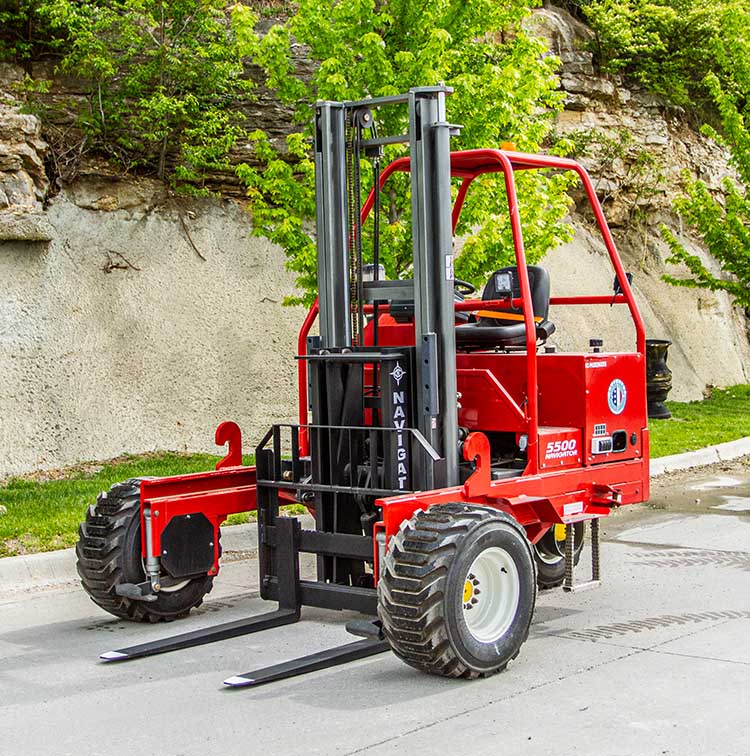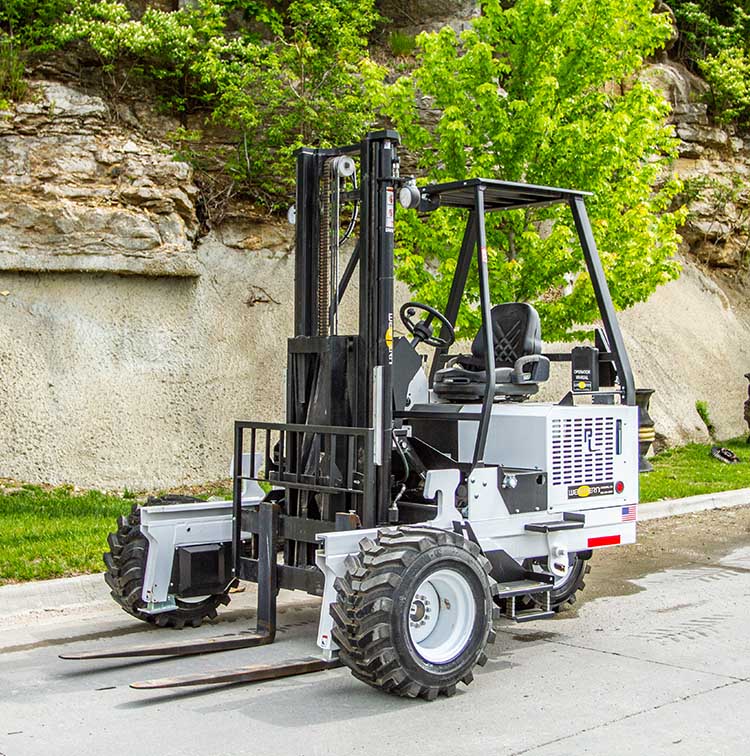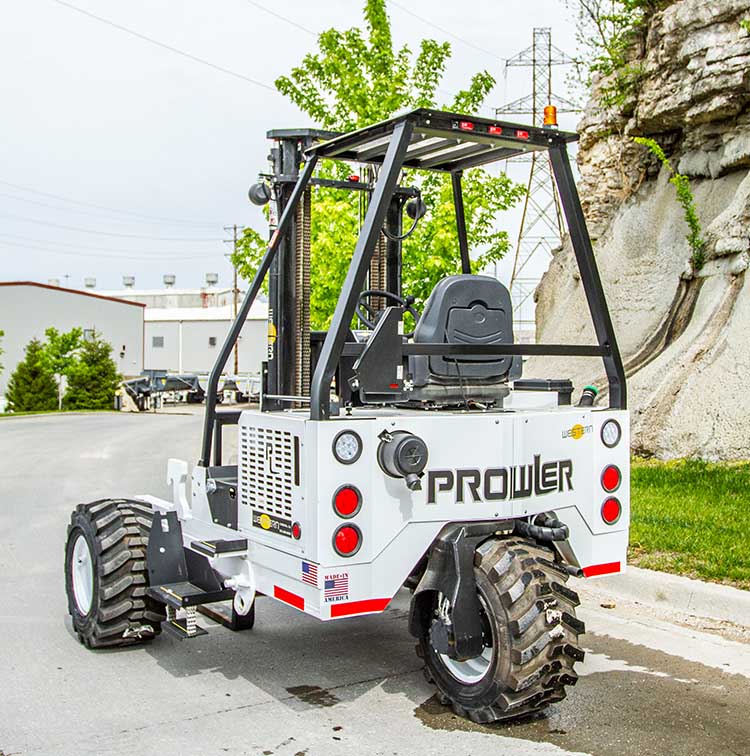

A piece of equipment that is both critical and commonplace in a variety of industrial applications is a truck-mounted forklift. (Also called a piggyback forklift, TMFL, all-terrain forklift, or Donkey.) The unit is essentially a truck that has an open, payload-carrying bed and a forklift attached to the back. The forklift is secured with hooks, chains, or latches that keep the equipment from shifting when the truck is in motion.
The vehicle carries material to a job site or a warehouse. Upon arrival, the forklift is detached and deployed – independently of the host truck – to load, unload, and move material on site. In other words, it is an integrated and highly cost-effective transport and handling system. According to Report Linker, the global forklift market is projected to grow to $13 billion by 2025. And within this segment, truck-mounted forklift units are expected to play a pivotal role, revolutionizing the trucking industry with a practical, 2-in-1 solution whose applications are almost endless.
WHICH INDUSTRIES USE TRUCK-MOUNTED FORKLIFTS?



Any industry that needs material to be transported and offloaded has a use for truck-mounted piggyback forklifts, which merge the functions of a lifting tool and a vehicle. Some of these industries include:
• Construction
Construction sites aren’t typically well-organized work areas. Equipment, tools, supplies, and crew members create unplanned congestion. A compact, piggyback forklift is just the right kind of machinery, with the maneuverability to unload materials like lumber, bricks, roofing shingles, and drywall in hard-to-reach or confined spaces.
• Recycling
In dusty, debris-ridden recycling centers, truck-mounted piggyback forklifts perform one of their toughest applications: offloading incoming material at processing stations and delivering baled paper, plastic, metal waste, etc. for outbound shipment by truck and rail.
• Warehouses and Distribution Centers
Forklifts unload and lift pallets of drums, crates, and stacked boxes, transporting goods to locations quickly and efficiently.
• Gas/LPG
With all-round visibility from the operator’s seat, forklifts transport potentially flammable containers safely, thereby eliminating the need for manual handling.
• Agriculture
In their agricultural application, piggyback forklifts carry materials to farms. They then act like a mechanical farmhand, delivering everything from fertilizers to animal feed and fencing supplies wherever they are needed on the property.
• Dockyards
These units move bulky containers from the truck body to dockside storage facilities and then on to cargo-carrying ships.
To help our readers get a better understanding of these units, we asked Dave Taff of Custom Trucks One Source, a leading seller of piggyback forklifts in the North American market, to deconstruct its two components – the flatbed and the forklift – for us.
Excerpts from the interview:
What is a flatbed?
A flat bed is a cab and chassis with an aluminum or steel flat body that can be anywhere from 10 ft. to 26 ft. But typically, for truck-mounted forklifts, the size is 24 ½ ft.
What kind of companies buy flatbeds?
All types of companies buy flatbeds. Anybody that hauls material of any type, whether it’s lumber or roofing or drywall or masonry supplies, needs flatbed trucks to transport cargo.
What are the advantages you offer that make Custom Truck One Source (CTOS) a one-stop shop for flatbed buyers?
Our wide network of locations. Our customer-first approach to services. The consistency in our builds because of our production capabilities. Then there is our pricing of course, which is going to be better because of volume purchasing.
Does CTOS build its own flatbeds?
Yes, 95% of our flatbed trucks are built by our manufacturing arm, Load King.
Do you see any chassis preference among buyers?
Generally speaking, a flatbed is purchased because it’s a cheaper unit as opposed to a drywall boom or a roofing conveyor. So, with that in mind, the typical use is a 33,000 GVW unit, whether it be a Freightliner, a Peterbilt, or an International.
Customers don’t show a clear brand preference, but in my experience, I have seen that the Freightliner M2106 does remarkably well.
The smaller GVWs are less expensive so they sell well across-the-board. Those who want a heavier-duty application may go up to a 66,000 GVW truck, possibly with a tag axle or pusher axle, but in such cases, economy is not the primary decision factor.
Moving on to forklifts, why are truck-mounted forklifts such a sought after commodity?
The primary reason for acquiring a truck-mounted forklift is to offload materials from the flatbed without the expense of owning a conveyor, a drywall boom, or a knuckle boom. So, if somebody is looking for a more economical purchase, they can buy a piggyback forklift instead to place materials on the ground for a ground drop.
If customers are in a situation where they don’t need to hoist the material onto a roof or inside a building, they could use a truck-mounted forklift and it would be a really nice and economical piece of machinery to own.
What brands of forklifts does Custom Truck offer?
We offer the Navigator forklift, which is built in Mississippi. They have 3 or 4 different models. The most popular model is the 5,500 lb capacity with extended reach (or Nav reach). This allows the customer to unload the bed from one side of the truck, because they can reach across the bed to pick up materials.
We also offer the Prowler Forklift, which outperforms competition and is the leading truck mounted rough terrain forklift in the industry. Our most popular model is the 5,500 lb capacity with an extended reach and is also made in the USA (Corona, California).
How do they compare to their competitors?
Some forklifts are side-seated machines. Ours are center-seated, which is more comfortable for the operator, because they are in the center of the machine, much like a warehouse forklift. Our units also have a little bit more of an overhang than some brands, because our wheelbase is longer, which allows for a more stable machine. If you visualize a forklift from a triangular point of view, the stability triangle is larger in a center-seated design than a side-seated machine with a shorter wheelbase.
Does Custom Truck sell forklifts on their own?
Yes, we do. We do both sales and rentals for piggyback and standalone forklifts.
Are there any safety ramifications in going with a piggyback forklift as opposed to, say, a drywall crane?
A: An operator has to be forklift certified to operate a forklift. However, they don’t have to have the intensive training they would need for a knuckle boom or a drywall boom. So, a driver could fairly simply pass an OSHA forklift test and be able to operate a forklift as opposed to the experience that might be necessary to operate a boom truck. You’re not operating it using a remote control. If you can drive a car, you should be able to drive a forklift. But not everybody has the skill set to operate a boom.

• Compared to industrial forklifts, truck-mounted units are lighter and more compact, and therefore more maneuverable.
• As they are mounted on the rear of a truck, they don’t take up valuable load space on the truck bed itself.
• They save on labor costs, because the 2-in-1 equipment can be operated by the same employee who can handle loading, transportation, and unloading door-to-door.
• They eliminate the need for manual offloading of heavy materials, thereby reducing risk of accidents.
• They can easily access unloading locations that are too cramped or congested for bigger load-carrying equipment.
• They can place pallets and other material anywhere and do not require a traditional loading and unloading dock.
• They offer a value-add service for truck delivery businesses that can be worked into the pricing, creating increased income.

A major factor depends on the application. If, for example, a customer wants to place material inside a building, then a forklift is not the right choice. But if they are looking to deliver equipment to a contractor who is going to move the material, then they can do that quickly with a forklift.
Another factor to consider is the capacity, what size pallets, and how heavy the pallets are going to be when offloading. These helps us size the forklift properly. Capacities vary (up to 8,000 lb) but our sweet spot is the 5,500 lb capacity, and that is typically what will be used in the building material market.
You also need to know how high you are going to reach. We offer our forklifts in 10 ft. masts and 12 ft. masts, because in some cases, like for residential job sites, we can raise the material up 12 ft and be able to place it in the first story of the house. But if they don’t need that because they’re only going to ground drop, then it is cheaper (and more stable) to use the 10 ft. mast.